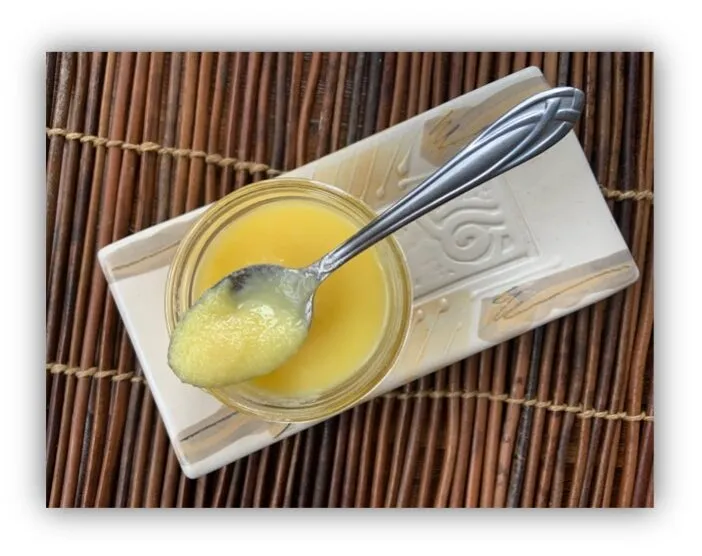Looking for cooking oil that is healthy, yet doesn’t mean you have to compromise taste?
Consider Ghee – the Ayurvedic cooking medium that’s been around for thousands of years. It has a rich buttery taste and aroma and comes with a host of benefits including its special ability to not only unclog, but to nourish the liver with its refined and healing properties.
What is Ghee?
Ghee is clarified butter – the butter oil, without the lactose and other milk solids. It is traditionally prepared by gently heating butter until it becomes a clear golden liquid. The lactose and other milk solids coagulate and are meticulously removed. This process also evaporates most of the natural water content, making Ghee light, pure and resistant to spoilage.
Ayurveda considers Ghee the ultimate cooking oil, with diverse mind/body benefits listed in the ancient texts.

Benefits of Ghee as recognized in the Ayurvedic texts:
- Absorption: Ghee is an integral part of the science ofAyurvedic herbal formulation. Since Ghee is an oil, it can bond with lipid-soluble nutrients and herbs to penetrate the lipid-based cell walls of the body. It is stated to increase the potency of certain herbs by carrying the active components to the interior of the cells where they impart the most benefit.
- Preservative: Ghee does not spoil easily, and actually preserves the original freshness and potency of herbs and foods. It does not need refrigeration.
- Digestion: The Ayurvedic texts say that Ghee helps balance excess stomach acid and helps maintain/repair the mucus lining of the stomach. Ghee not only is easily processed by the liver, but it also helps to nourish and maintain the liver and its functioning. Other animal and plant-based oils are too heavy for the liver to digest and can contribute to liver stagnation.
- Mild Burns: Like aloe, Ghee is said to prevent blister and scarring if applied quickly to affected skin
- Mind: Ghee is said to promote all three aspects of mental functioning – learning, memory and recall. And is a special rejuvenative for the brain and nerve tissue.
- Ayurvedic Balance: Ghee balances both Vata (the Ayurvedic mind/body operator that controls movement of mind and body) and Pitta (the operator that controls digestion and metabolism).
If you want to learn about more beneficial foods and practices, you can get direct and meaningful help with Personalized Wellness Coaching.
Ghee had been given the cherished title of Rasayana in Ayurveda; a pre-eminent herb or food that helps overall health, longevity and well-being.
The Right Kind of Fat

- It is generally recognized that some fat is essential for health. A totally fat-free diet can actually accelerate aging of the skin, nerves and brain cells. Without an adequate quantity of the right kind of fat in the diet, cell regeneration can be adversely impacted. Fats are needed for efficient absorption of crucial lipid- soluble vitamins such as A, E, D and K.
- The stomach lining, which protects the stomach from the acids it secretes to help break down foods, needs fat to maintain a healthy coating. Similarly, cholesterol in the body serves functions that are crucial to health, such as building cell membranes and hormone and bile balance. It is only when cholesterol is damaged by harmful free radicals that it leads to clogged arteries and heart problems.
- Ghee imparts the benefits of the best essential fatty acids without the problems of oxidized cholesterol, trans fatty acids or hydrogenated fats. It is also resistant to free radical damage and is both salt and lactose free.
A Versatile Cooking Medium
Ghee has an excellent aroma. It has a very high burning point and doesn’t burn or smoke during cooking. It combines profoundly with a wide variety of spices. You can use Ghee to sauté foods, in baking, to deep-fry, or even as a spread.
How to Make Ghee
Never leave a pot of boiling butter unattended. Ghee can quickly go from completed to burnt.
- Slowly bring one pound of organic unsalted butter to a gentle boil.
- Butter should be simmering under the foamy white layer on top, but not boiling through. Do not stir.
- Ghee is done when the milk solids on top have reduced and turned “slightly” brown, the milk solids on the bottom of the pot are slightly brown, the ghee gives off a slight hissing sound and there is a notable nutty aroma.
- Remove from heat. Gently strain off the milk solids from the top.
- Place a couple layers of cheese cloth onto a metal strainer over a wide mouth jar. Gently pour the ghee through the strainer into the jar.
- One pound of butter will make approx 2 cups – 500 ml of ghee.
Try this experiment…Make two batches of ghee – one with organic butter and one with un-organic butter – notice the differences….
Time-Tested Natural Medicine with Ghee
The uses for ghee within the realm of Ayurvedic Healing is vast and profound. Ghee can be used as the foundation for herbal oils to calm the mind, clear the sinuses, rejuvenate the skin and settle digestion. Studying Ayurveda with an experienced Ayurvedic herbalist is a great opportunity to learn how to make your own herbal ghees to support health and well-being for all within your home.



